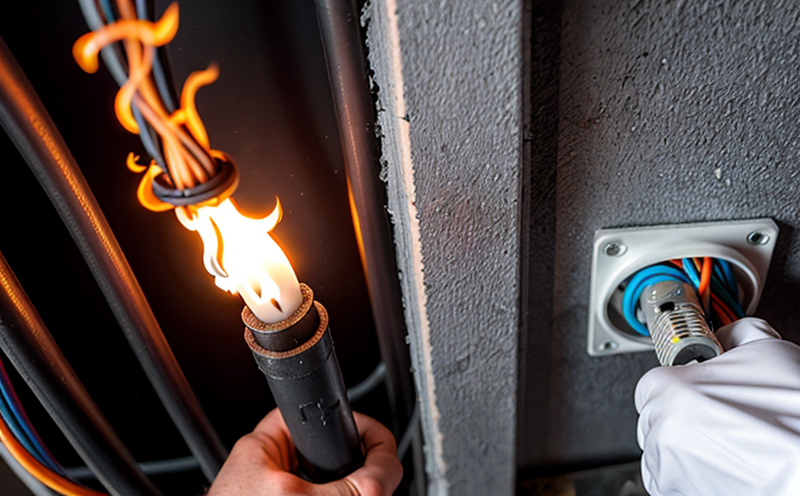Fire Reaction Testing of XLPE Insulated Cables
The fire reaction testing of cross-linked polyethylene (XLPE) insulated cables is a critical process to ensure that these materials meet stringent safety standards and regulatory requirements. These tests are essential for assessing the behavior of materials when exposed to flame, which helps in understanding their potential to spread or inhibit flames. XLPE insulation is widely used in various electrical applications due to its excellent mechanical properties, chemical resistance, and dielectric strength. However, it must also meet specific fire safety standards to prevent hazards during accidental ignition.
The testing process involves subjecting a sample of the cable to controlled conditions that simulate real-world scenarios where there might be an ignition source. This could include exposure to heat, flame, or other environmental factors that are conducive to combustion. The primary objective is to evaluate how the material reacts under these conditions and determine its resistance to spreading flames.
The testing methodologies often involve specialized equipment such as a cone calorimeter or oxygen index tester, which provide precise measurements of the material’s flammability characteristics. These instruments help in quantifying key parameters like heat release rate (HRR), smoke production, and mass loss during combustion. The results from these tests are crucial for manufacturers and designers to optimize their products for safety while maintaining performance.
Compliance with relevant standards is paramount in this field. For example, ASTM E1354-20 specifies the procedure for determining the burning behavior of electrical insulation materials under controlled conditions using a cone calorimeter. This standard provides detailed guidance on specimen preparation, test setup, and data interpretation to ensure consistency across different laboratories.
The importance of accurate testing cannot be overstated. Inappropriate or non-compliant cables can lead to severe safety risks in both commercial and residential settings. Electrical fires are one of the leading causes of property damage and injury worldwide. Therefore, ensuring that materials like XLPE insulation meet rigorous fire resistance standards is vital for public safety.
Eurolab’s expertise in this area ensures reliable and consistent test results. Our state-of-the-art facilities and experienced staff guarantee that every sample undergoes thorough evaluation according to established protocols. This commitment to quality control allows us to deliver accurate data that can be relied upon by stakeholders across the industry.
Why It Matters
The safety of electrical installations is paramount, especially in environments where there is a high risk of fire due to the presence of flammable materials or potential ignition sources. XLPE insulated cables play a crucial role in these systems by providing reliable insulation while resisting flame spread and degradation when exposed to heat or flames.
Fire resistance testing ensures that the cable can withstand initial exposure to fire without rapid melting, burning, or releasing toxic gases. It also evaluates the material’s ability to self-extinguish after ignition has been removed. These properties are essential for preventing catastrophic failures in critical infrastructure such as power substations, hospitals, and data centers.
In addition to safety considerations, fire resistance testing plays a significant role in ensuring regulatory compliance. Many countries have strict regulations regarding the flammability of electrical insulation materials used in public buildings and facilities. Meeting these requirements not only protects against potential accidents but also demonstrates a commitment to responsible manufacturing practices.
Moreover, the results from such tests contribute valuable information for continuous improvement within the industry. By identifying areas where improvements can be made, manufacturers can develop safer products that offer enhanced performance over time. This ongoing effort towards innovation is crucial in maintaining trust and confidence among consumers who rely heavily on electrical systems for daily operations.
Applied Standards
The application of appropriate standards ensures consistency and reliability in fire resistance testing procedures across different laboratories worldwide. Some key international standards that govern this process include:
- ASTM E1354-20: Procedure for Determining the Burning Behavior of Electrical Insulation Materials using a Cone Calorimeter.
- ISO 6944:2015: Classification and testing of flame retardant plastics used in electrical and electronic applications.
- EN 384-1: Specification for Flame Retardant Plastics Used in Electrical and Electronic Applications.
- IEC 60754-2:2018: Specification for Electrical Insulation Materials used in Power Transformers, Instrument Transformers, and Surge Arresters.
These standards provide clear guidelines on specimen preparation, test procedures, and acceptable limits for various parameters such as heat release rate (HRR), smoke density, and mass loss. Compliance with these specifications demonstrates that the tested samples meet industry-recognized benchmarks for safety and performance.
Eurolab Advantages
At Eurolab, we pride ourselves on delivering exceptional service to clients involved in fire safety testing of XLPE insulated cables. Our comprehensive approach encompasses all aspects of the testing process, from initial consultation through final report delivery.
- Expertise and Experience: Our team consists of highly qualified professionals with extensive experience in fire resistance testing. They stay updated on the latest developments in materials science and safety regulations to ensure that our clients receive cutting-edge solutions tailored specifically for their needs.
- State-of-the-Art Facilities: Equipped with advanced instrumentation like cone calorimeters and smoke testers, we can conduct precise and repeatable tests. This ensures accurate measurement of critical parameters such as HRR, smoke generation, and mass loss during combustion.
- Comprehensive Reporting: Every test conducted at Eurolab results in a detailed report that provides comprehensive insights into the performance characteristics of the tested sample. These reports are backed by robust data analysis techniques that help our clients make informed decisions about their product development or compliance strategies.
- Client-Centric Approach: We understand that each client has unique requirements, whether it be for regulatory compliance or internal quality assurance purposes. Our flexible approach allows us to accommodate these diverse needs while maintaining the highest standards of accuracy and reliability.
By choosing Eurolab for your fire resistance testing needs, you can expect nothing less than excellence in service delivery. Trust us to provide you with reliable results that meet or exceed industry expectations.





